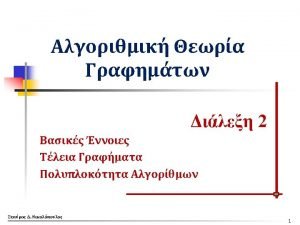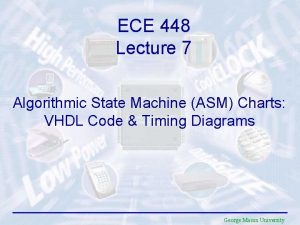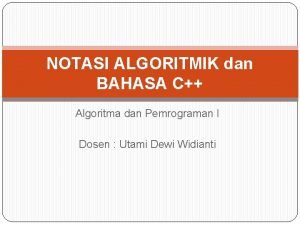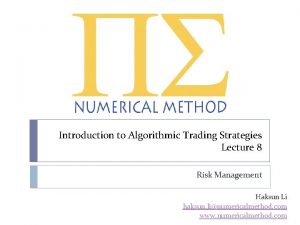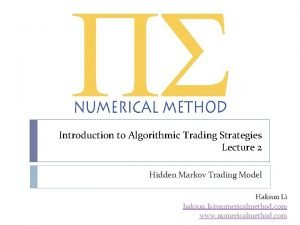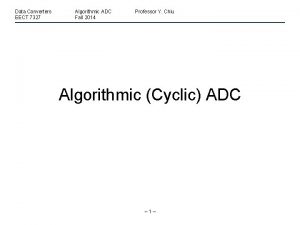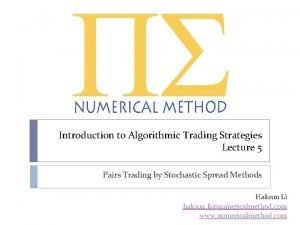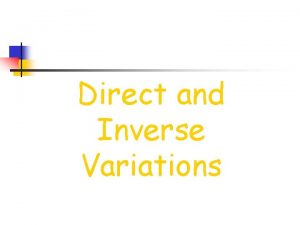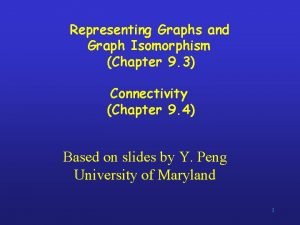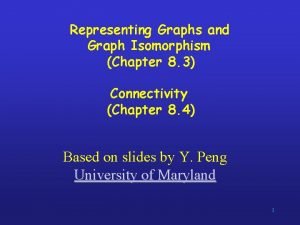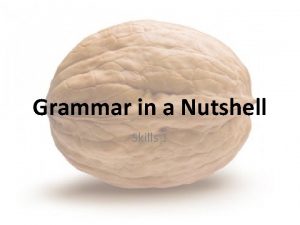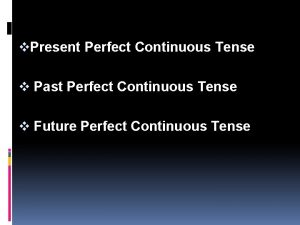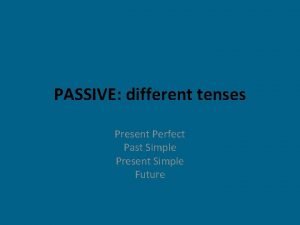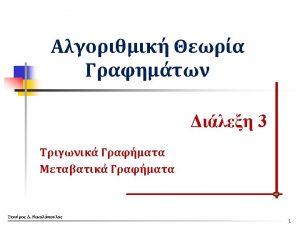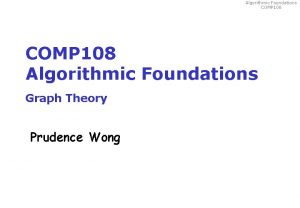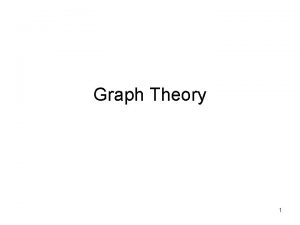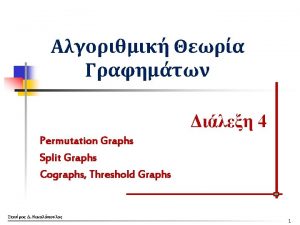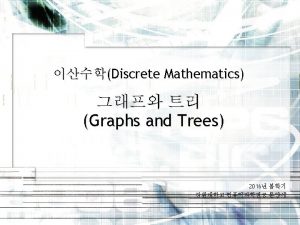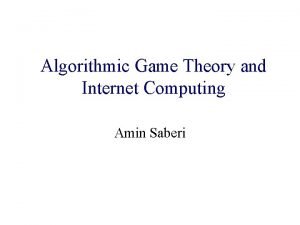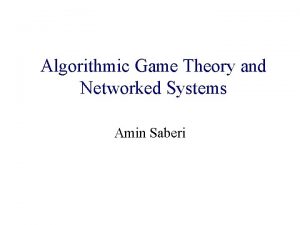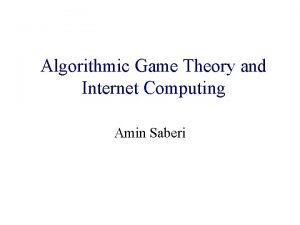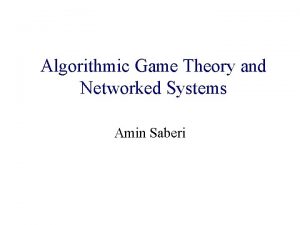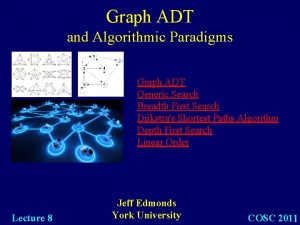Classes of Perfect Graphs 3 Algorithmic Graph Theory



























![Objects - Transformations w π = [π1 , π2, …, πn] G 28 Objects - Transformations w π = [π1 , π2, …, πn] G 28](https://slidetodoc.com/presentation_image_h/10cd301a499a1d3dcdc5e083f310cd0d/image-28.jpg)

























![The Design of Efficient Algorithms n Example: matrix multiplication - Strassen [1969] - Pan The Design of Efficient Algorithms n Example: matrix multiplication - Strassen [1969] - Pan](https://slidetodoc.com/presentation_image_h/10cd301a499a1d3dcdc5e083f310cd0d/image-54.jpg)










- Slides: 64



Classes of Perfect Graphs 3

Algorithmic Graph Theory Notations - Terminology Graph Theoretic Foundations 4


Graph Theoretic Foundations n Regular Graphs: n Κυκλικό γράφημα (Cn): όλοι οι κόμβοι d(v)=2 (κυβικός k = 3) 6

Graph Theoretic Foundations Induced Subgraphs n n Let A V. We define the subgraph induced by A to be GA = (A, EA), where EA = {(x, y) EA | x A and y A} Not every subgraph GA of G is an induced subgraph of G. 1 2 1 3 3 4 4 5 6 6 7

Graph Theoretic Foundations Induced Subgraphs 1 2 1 3 2 3 4 4 4 6 V’= {1, 3, 4, 6} G [V’] 3 4 5 6 6 G = (V, E) 2 5 6 5 1 3 V’ V’ ? ? 8

Graph Theoretic Foundations Isomorphic Graphs n G = (V, E) and G′ = (V′, E′) are isomorphic, denoted G G′, if a bijection f: V V′: (x, y) E (f(x), f(y)) E′ x, y V • 1, 2, 3, 4, 5, 6 • 1, 5, 4, 3, 6, 2 (2, 6) E (5, 6) E’ 9

Graph Theoretic Foundations Isomorphic Graphs 10

Graph Theoretic Foundations Isomorphic Graphs 11

Graph Theoretic Foundations Isomorphic Graphs 12

Graph Theoretic Foundations Isomorphic Graphs 13

Graph Theoretic Foundations Operations 2 G 1 2 6 1 3 5 4 G 1 G 2 2 1 3 1 5 4 G 2 2 2 1 3 4 6 3 1 3 4 5 4 G 1 G 2 6 G 1 G 2 14

Graph Theoretic Foundations Operation + + Κ 2 Κ 3 (complete graph) Wn (wheel graph) + Κ 1 (N 1) Κ 5 Cn-1 15

Graph Theoretic Foundations Cartesian Product G 1 G 2 ? G 1 G 2 G 1 G 2 G 1 Lexicographic Product G 1[G 2] ? G 1 G 2 G 1[G 2] G 2[G 1] 16

Algorithmic Graph Theory Intersection Graphs Object – Graph Properties 17

Intersection Graphs n n Let F be a family of nonempty sets. The intersection graph of F is obtained be representing each set in F by a vertex: x y SX ∩ S Y ≠ 18

Intersection Graphs (Interval) n The intersection graph of a family of intervals on a linearly ordered set (like the real line) is called an interval graph I 1 I 3 I 2 2 I 5 I 4 1 I 6 I 7 n n Unit & Proper internal graph No internal property contains another 3 6 7 4 5 19

Intersection Graphs (Circular-arc) n Circular-arc graphs properly contain the internal graphs. 5 8 9 6 1 4 1 7 3 2 n proper circular - arc graphs 20

Intersection Graphs (Permutation) n A permutation diagram consists of n points on each of two parallel lines and n straight line segments matching the points. 1 2 3 4 π = [4, 1, 3, 2] 4 1 1 3 2 2 G[π] 4 3 21

Intersection Graphs (Chords-of-circle) n Intersecting chords of a circle 3 2 4 2 1 4 3 3 4 2 1 1 22

Intersection Graphs (cont…) n n Propositinon 1. 1. An induced subgraph of an interval graph is an interval graph. In general… Hamiltonian non-Hamiltonian 23

Intersection Graphs (cont…) n Propositinon 1. 1. An induced subgraph of an interval graph is an interval graph. Proof ? G Interval 24

Intersection Graphs (cont…) n Propositinon 1. 1. An induced subgraph of an interval graph is an interval graph. Proof ? G G’ Interval G’ 25

Intersection Graphs (cont…) n Propositinon 1. 1. An induced subgraph of an interval graph is an interval graph. Proof. If [IV], v V, is an interval representation of a graph G = (V, E). Then q [IV], v X, is an interval representation of the induced subgraph GX = (X, EX). 26

Algorithmic Graph Theory Objects Transformations 27
![Objects Transformations w π π1 π2 πn G 28 Objects - Transformations w π = [π1 , π2, …, πn] G 28](https://slidetodoc.com/presentation_image_h/10cd301a499a1d3dcdc5e083f310cd0d/image-28.jpg)
Objects - Transformations w π = [π1 , π2, …, πn] G 28

Algorithmic Graph Theory Triangulated Property Transitive Orientation Property 29

Triangulated Property n Triangulated Graph Property Every simple cycle of length l > 3 possesses a chord. n Triangulated graphs (or chord graphs) 30

Transitive Orientation Property n Transitive Orientation Property Each edge can be assigned a one-way direction in such a way that the resulting oriented graph (V, F): ab F and bc F ac F ( a, b, c V) n Comparability graphs 31

Intersection Graph Properties (1) n Proposition 1. 2. An interval graph satisfies the triangulated graph property. Proof. Suppose G contains a cordless cycle [v 0, v 1, …. , vl-1, v 0] with l > 3. Let IK v. K. For i =1, 2, …, l-1, choose a point Pi Ii-1 ∩ Ii. Since Ii-1 and Ii+1 do not overlap, the points Pi constitute a strictly increasing or decreasing sequence. Therefore, it is impossible for the intervals I 0 and Il-1 to intersect, contradicting the criterion that v 0 vl-1 is an edge of G. 32

Intersection Graph Properties (2) n Proposition 1. 3. The complement of an internal graph satisfies the transitive orientation property. Proof (1). G Interval 33

Intersection Graph Properties (3) n Proposition 1. 3. The complement of an internal graph satisfies the transitive orientation property. Proof (1). _ G Interval 34

Intersection Graph Properties (4) n Proposition 1. 3. The complement of an internal graph satisfies the transitive orientation property. Proofv (2). Let {Iv} v V be the interval representation for G = (V, E). Define an orientation F of Ğ = (V, Ē) as follows: xy F IX < IY ( xy Ē). Here, IX < IY means that IX lies entirely to the left of IY. Clearly the top is satisfied, since IX < IY < IZ IX < IZ. Thus F is a transitive orientation of Ğ. 35

Intersection Graph Properties (5) n Theorem 1. 4. An undirected graph G is an interval graph if and only if (iff) q G is triangulated graph, and q its complement Ğ is a comparability graph. Proof… M. Golumbic, pp. 172. 36

Algorithmic Graph Theory Numbers ω(G) α(G) k(G) x(G) 37

Graph Theoretic Foundations (2) n n Clique number ω(G) the number of vertices in a maximum clique of G Stability number α(G) the number of vertices in a stable set of max cardinality Max κλίκα του G a b c e d f b e c d ω(G) = 4 Max stable set of G a f c α(G) = 3 38

Graph Theoretic Foundations (3) n A clique cover of size k is a partition V = C 1 + C 2 +…+ Ck such that Ci is a clique. n A proper coloring of size c (proper c-coloring) is a partition V = X 1 + X 2 +…+ Xc such that Xi is a stable set. 39

Graph Theoretic Foundations (4) n n Clique cover number κ(G) the size of the smallest possible clique cover of G Chromatic number χ(G) the smallest possible c for which there exists a proper c -coloring of G. 4 3 χ(G) = 2 5 1 ω(G)=2 2 κ(G) = 3 clique cover V={2, 5}+{3, 4}+{1} c-coloring V={1, 3, 5}+{2, 4} α(G)=3 40

Graph Theoretic Foundations (1) n Observation. . . Each of the graphs can be colored using 3 colors and each contains a triangle. Therefore, χ(G) = ω(G) 41

Graph Theoretic Foundations (5) n For any graph G: ω(G) ≤ χ(G) α(G) ≤ κ(G) n Obviously: α(G) = ω(Ğ) and κ(G) = χ(Ğ) 42

Algorithmic Graph Theory χ-Perfect property α-Perfect property Perfect Graphs 43

Perfect Graphs - Properties n χ-Perfect property For each induced subgraph GA of a graph G χ(GA) = ω(GA) n α-Perfect property For each induced subgraph GA of a graph G α(GA) = κ(GA) 44

Perfect Graphs - Definition n Let G = (V, E) be an undirected graph: (P 1) ω(GA) = χ(GA) (P 2) α(GA) = κ(GA) for all A V For each induced subgraph GA of a graph G !!! G is called… Perfect Graph 45

The Perfect Graph Theorem n Lovasz (1972): For an undirected graph G = (V, E), the following statements are equivalent: (P 1) ω(GA) = χ(GA) for all A V (P 2) α(GA) = κ(GA) for all A V (P 3) ω(GA)α(GA) |Α| for all A V 46

The Strong Perfect Graph Conjecture n Claude Berge (1960): SPGC 1: An undirected graph G is Perfect iff contains no induced subgraph isomorphic to C 2 k+1 or co-C 2 k+1 (for k 2). SPGC 2: An undirected graph G is Perfect iff in G and in co-G every odd cycle of length l 5 has a chord. 47

The Strong Perfect Graph Conjecture n Maria Chudnovsky, Neil Robertson, Paul Seymour, Robin Thomas (2002): SPGT: G is Perfect iff it contains neither odd holes nor odd antiholes. The strong perfect graph theorem is a forbidden graph characterization of the perfect graphs as being exactly the graphs that have neither odd holes (odd-length induced cycles) nor odd antiholes (complements of odd holes). Classroom Project 48

Classes of Perfect Graphs 49

Algorithmic Graph Theory Algorithms Graph Theory 50

The Design of Efficient Algorithms n n n Computability – computational complexity Computability addresses itself mostly to questions of existence: Is there an algorithm which solves problem Π? An algorithm for Π is a step-by-step procedure which when applied to any instance of Π produces a solution. 51

The Design of Efficient Algorithms n Rewrite an optimization problem as a decision problem Graph Coloring Instance: A graph G Graph Coloring Question: What is the smallest number of colors needed for a proper coloring of G? Question: Does there exist a proper k coloring of G? Instance: G and k Z+ 52

The Design of Efficient Algorithms n Determining the complexity of a problem Π requires a two-sided attack: 1. The upper bound – the minimum complexity of all known algorithms solving Π. 2. The lower bound – the largest function f for which it has been proved (mathematically) that all possible algorithms solving Π are required to have complexity at least as high as f. § Gap between (1) - (2) research 53
![The Design of Efficient Algorithms n Example matrix multiplication Strassen 1969 Pan The Design of Efficient Algorithms n Example: matrix multiplication - Strassen [1969] - Pan](https://slidetodoc.com/presentation_image_h/10cd301a499a1d3dcdc5e083f310cd0d/image-54.jpg)
The Design of Efficient Algorithms n Example: matrix multiplication - Strassen [1969] - Pan [1979] n O(n 2. 81) O(n 2. 78) O(n 2. 6054) n >> The lower bound known to date for this problem is only O(n 2) [Aho, Hoproft, Ullman, 1994, pp 438] 54

The Design of Efficient Algorithms n n The biggest open question involving the gap between upper and lower complexity bounds involves the so called NP-complet problems. Π NP-complete only exponential-time algorithms are known, yet the best lower bounds proven so far are polynomial functions. 55

The Design of Efficient Algorithms n n n Π P if there exists a “deterministic” polynomial-time algorithm which solves Π A nondeterministic algorithm is one for which a state may determine many next states and which follows up on each of the next states simultaneously. Π NP if there exists a “nonderminitic” polynonial-time algorithm which solves Π. 56

The Design of Efficient Algorithms n n Clearly, P NP Open question is whether the containment of P in NP is proper is P ≠ NP ? 57

The Design of Efficient Algorithms n Π NP – complete if Π NP and Π NP-hard n Repeat the following instructions: 1. Find a candidate Π which might be NP-complete 2. Select Π΄ from the bag of NP-complete problems 3. Show that Π NP and Π΄≤ Π 4. Add Π to the bag 58

The Design of Efficient Algorithms n Theorem (Poljak (1974)): n STABLE SET ≤ STABLE SET ON TRIANGLE-FREE GRAPHS Proof Let G be a graph on n vertices and m edges. We construct from G a triangle-tree graph H with the properly that : Knowing α(H) will immediately give us α(G) G 59

The Design of Efficient Algorithms Subdivide each edge of G into a path of length 3 H is triangle-free with H n+2 m vertices, and 3 m edges Also, H can be constructed from G in Ο(n+m) Finally, since α(H) = α(G) + m, a deterministic polynomial time algorithm which solves for α(H) yields a solution to α(G). 60

The Design of Efficient Algorithms q Since it is well known that STABLE SET is ` NP -complete, we obtain the following lesser known result. Corollary: STABLE SET ON TRIANGLE-FREE GRAPHS is NP -complete. § Theorem (Poljak(1974)): STABLE SET ≤ GRAPH COLORING 61

The Design of Efficient Algorithms n Some NP-complete Problems n n n Graph coloring instance: G question: What is χ(G)? § Stable set instance : G question: What is α(G)? § Clique cover Clique instance : G question: What is κ(G)? question: What is ω(G)? Perfect graphs Optimization Problems? 62

Algorithmic Graph Theory Classes of Perfect Graphs Optimization Problems 63

Perfect Graphs – Optimization Problems Πολυωνυμικοί Αλγόριθμοι Προβλημάτων Αναγνώρισης Triangulated Comparability Interval Permutation Split Cographs Threshold graphs QT graphs … Βελτιστοποίησης Coloring Max Clique Max Stable Set Clique Cover Matching Hamiltonian Path Hamiltonian Cycle … 64
 Algorithmic graph theory and perfect graphs
Algorithmic graph theory and perfect graphs Classe e subclasse de palavras 3.o ano
Classe e subclasse de palavras 3.o ano Pre ap classes vs regular classes
Pre ap classes vs regular classes What is state graph in software testing
What is state graph in software testing Comparing distance/time graphs to speed/time graphs
Comparing distance/time graphs to speed/time graphs Graphs that enlighten and graphs that deceive
Graphs that enlighten and graphs that deceive Which two graphs are graphs of polynomial functions?
Which two graphs are graphs of polynomial functions? Line graph graph theory
Line graph graph theory Verbo to be present perfect
Verbo to be present perfect Algorithmic trading singapore
Algorithmic trading singapore Asm chart for mealy machine
Asm chart for mealy machine Algorithmic thinking gcse
Algorithmic thinking gcse Algorithmic nuggets in content delivery
Algorithmic nuggets in content delivery Algorithmic cost modelling
Algorithmic cost modelling Algoritma adalah
Algoritma adalah Introduction to algorithmic trading strategies
Introduction to algorithmic trading strategies Introduction to algorithmic trading strategies
Introduction to algorithmic trading strategies Input output algorithm
Input output algorithm Low frequency algorithmic trading
Low frequency algorithmic trading Introduction to algorithmic trading strategies
Introduction to algorithmic trading strategies Algorithmic adc
Algorithmic adc Introduction to algorithmic trading strategies
Introduction to algorithmic trading strategies Algorithmic event correlation
Algorithmic event correlation Algorithmic state machine examples
Algorithmic state machine examples Gdpr algorithmic bias
Gdpr algorithmic bias Game theory and graph theory
Game theory and graph theory Networks and graphs circuits paths and graph structures
Networks and graphs circuits paths and graph structures What is the difference between inverse and direct variation
What is the difference between inverse and direct variation Representing graphs and graph isomorphism
Representing graphs and graph isomorphism Representing graphs and graph isomorphism
Representing graphs and graph isomorphism Perfect competition side by side graphs
Perfect competition side by side graphs Wait-for graph
Wait-for graph Shutdown point in perfect competition
Shutdown point in perfect competition Perfect matching graph
Perfect matching graph Went vs gone
Went vs gone Present perfect structure question
Present perfect structure question Present perfect simple vs present perfect continuous
Present perfect simple vs present perfect continuous Perfect and perfect progressive tenses
Perfect and perfect progressive tenses Past simple past continuous present perfect
Past simple past continuous present perfect Cuando usar past perfect y past simple
Cuando usar past perfect y past simple Past perfect continuous and past simple
Past perfect continuous and past simple Perfect englisch grammar
Perfect englisch grammar Future perfect continuous exercises
Future perfect continuous exercises Past simple i past continuous i past perfect
Past simple i past continuous i past perfect Perfect infintive
Perfect infintive Cubrir past tense
Cubrir past tense Perfect tense past perfect tense
Perfect tense past perfect tense Present perfect vs. present perfect continuous
Present perfect vs. present perfect continuous Keywords present perfect progressive
Keywords present perfect progressive Is 1728 a perfect square
Is 1728 a perfect square Past perfect tense examples
Past perfect tense examples Czas present perfect tense
Czas present perfect tense Present perfect tense vs present perfect continuous tense
Present perfect tense vs present perfect continuous tense Past simple remember
Past simple remember Present perfect present progressive
Present perfect present progressive Uses of past perfect progressive tense
Uses of past perfect progressive tense Tenses in a nutshell
Tenses in a nutshell Chapter 3 perfect and perfect progressive tenses
Chapter 3 perfect and perfect progressive tenses Future perfect e future continuous
Future perfect e future continuous Present perfect continuous auxiliary verb
Present perfect continuous auxiliary verb Subjunctive present perfect
Subjunctive present perfect Present perfect vs present perfect continuous
Present perfect vs present perfect continuous Past simple passive
Past simple passive Past perfect vs past perfect continuous
Past perfect vs past perfect continuous Future continuous
Future continuous
